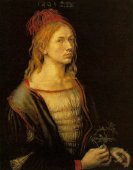Albrecht Dürer, the Greatest German Artist
Albrecht D�rer
Reading Comprehension for May 21
You might say that Albrecht Dürer (AHL-brekht DYOO-rer) had a golden childhood. His father was a goldsmith, and his mother was the daughter of a goldsmith, but Albrecht's golden touch was artistic, not metallic.
Albrecht Dürer has been called the greatest German Renaissance artist and perhaps the greatest German artist of all time. He was born in Nuremburg on May 21, 1471. At that time, Nuremberg was part of the Holy Roman Empire, and many European trade routes passed through the bustling city. Albrecht's parents surrounded him with culture from a young age, from religious paintings to beautifully engraved golden objects. Albrecht's father began to train him to be a goldsmith, but Albrecht's drawing talent led him to become an apprentice in an artist's workshop just a few doors away.
Albrecht had remarkable talent and could draw anything, including a stunning self-portrait at age thirteen. The drawing shows a sensitive boy with a pointy chin looking out with a shy, sideways glance. He also learned how to design woodcuts and how to paint on wooden panels. A woodcut was just a block of wood that was carved and inked to make prints.
Albrecht's training was finished in 1490, and his father sent him on a "workman's journey." At that time, most young men took this kind of trip in order to complete their training. It allowed a young person to quickly achieve mastery in his chosen profession, and it also probably kept him out of trouble! Albrecht traveled for two years and then took a job in a shop making drawings for woodcuts.




